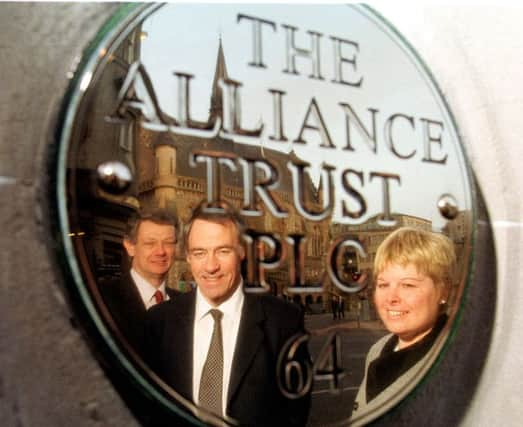Bill Jamieson: Lack of leadership has put Alliance Trust in play


It’s shocking because the approach – from RIT Capital Partners – has effectively put in play one of Scotland’s largest and most enduring investment houses.
We’ve grown used in Scotland to having our standing as a once-distinctive, proud and robust fund management centre being chipped away by merger and takeover. We had a great set of mutual life offices, now almost all gone. We had a wide range of investment houses – now thinned out. And Scotland’s biggest banks had investment arms – now all but amputated.
Advertisement
Hide AdAdvertisement
Hide AdBut the potential loss of Alliance as an independent investment house – headquartered, managed and run out of Scotland – removes not just a brick in the wall but a founding corner-stone of our presence in investment trusts.
How has it come to this? It is all too predictable. It follows years of indifferent performance, shareholder criticism, half-hearted attempts at reform – and a woeful absence of dynamic leadership that could – and should – have driven this once great company out of the doldrums.
By no means all Alliance Trust investors will be shedding tears. They have endured a succession of hopes, promises and disappointments, activist shareholder revolts and rebellions, calls for performance to be improved, the discount to be narrowed, loss-making subsidiaries sold off and new management brought in.
Bulging pay packets in a boardroom that presided over near-constant disappointment was the final bitter cherry in this lacklustre Dundee cake.
The approach by RIT – an outstandingly successful trust where the Rothschild family is a minority investor – opens the door to other merger approaches – and to a more hopeful future.
Alliance is still one of the largest investment trusts in Britain – and with the potential to be much larger and certainly more successful than the total assets of £3.3 billion it currently oversees.
And while there is much that I, and others, have criticised in recent years, there is much to respect and admire.
The trust has a huge retail following built up over decades. “Investing for generations” is no vapid PR slogan but the reality for many thousands who have inherited their holdings from parents and grandparents. It has worked hard to introduce and explain the investment trust concept to new investors. Its reports are models of information, explanation and disclosure.
Advertisement
Hide AdAdvertisement
Hide AdIt has sought to offer a broad, generalist portfolio with diversification across geographies, asset types and activity specialisms to appeal to cautious investors.
Management charges are among the lowest in the industry and its investor platform, available through Alliance Trust Savings, makes buying and selling a simple operation. It also has a well-resourced information and research centre.
Yet the trust, despite fitful improvement, has failed to shake off two features that have bedevilled it – a large gap between the market value of its shares and the value of the underlying investments held by the trust – the discount to net assets. Even after news of the RIT approach last week, Alliance shares still stand at a discount to net assets of 9.81 per cent.
And there has been a succession of management changes. Chief executive Katherine Garrett-Cox left Alliance Trust last year after almost eight years in charge and Karin Forsake, its chairman, left last November. Both had fought – and failed – to see off an activist boarding party led by Elliott Partners.
The investment style has swung from a strong focus on dividend income through a flirtation with a modern, “multi-asset” approach (including private equity) to more traditional stock picking methods with an emphasis on explicitly ethical or “socially responsible” investment. But a sustained performance break-out has still eluded it.
The RIT approach is likely to whet the appetites of rival fund management companies keen to expand – or just cherry pick Alliance assets and customers. For all its trials and tribulations, Alliance would still be a formidable catch. But the new board under Robert Smith, which is already undertaking a strategic review, could choose to soldier on with plans of its own. This would preserve its Scottish headquarters and independence. But shareholder patience in new in-house approaches may be exhausted by now. For a trust with such a noble and pioneering history, what a sad end to what in recent years lapsed into a sorrowful song.